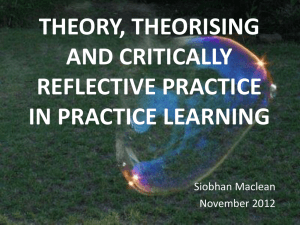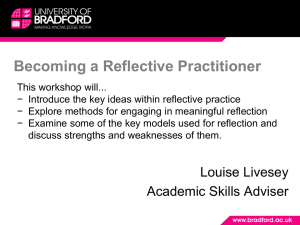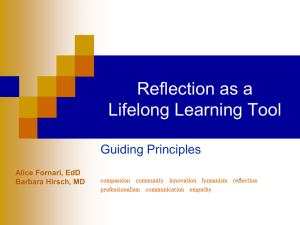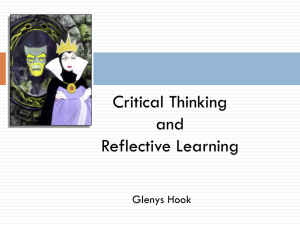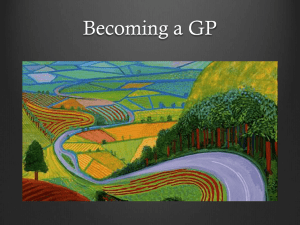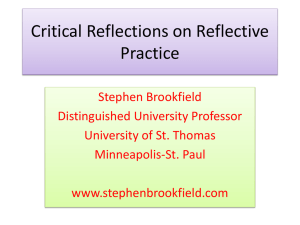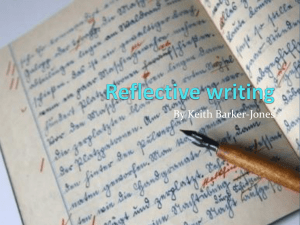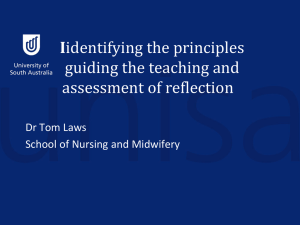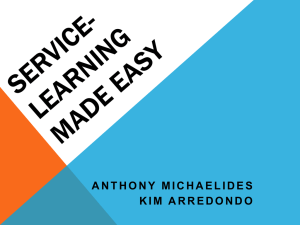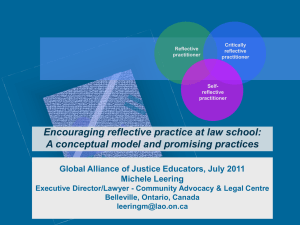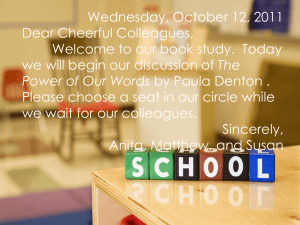Critcally reflective practice – Siobhan MacLean
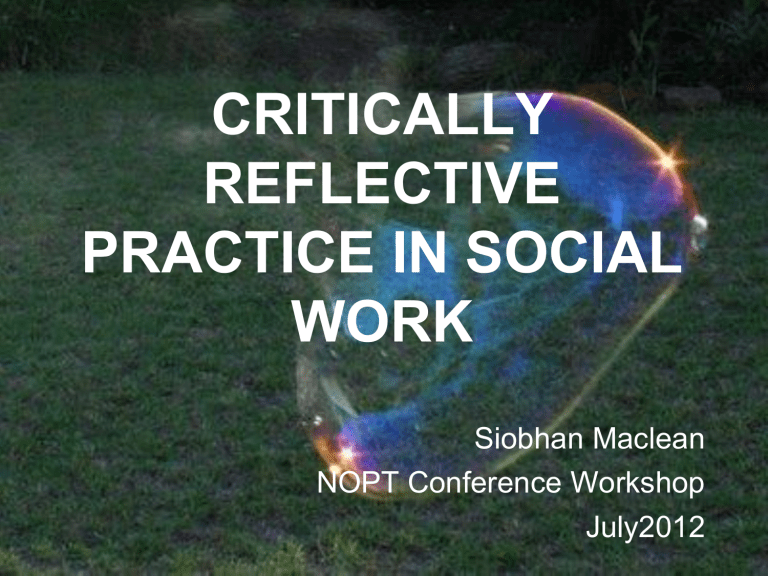
CRITICALLY
REFLECTIVE
PRACTICE IN SOCIAL
WORK
Siobhan Maclean
NOPT Conference Workshop
July2012
Critical reflection
• Domain 6 of the PCF: Critical reflection and analysis
• Essentially draws together holistic assessment
• HCPC Standards of Proficiency for Social
Workers in England – standard 11: be able to reflect on and review practice
• Guidance on critical reflection is in development to support the PCF
Despite this there are a number of barriers….
Difficulties / barriers
Time constraints
Striving for certainty
Evidence based practice
Reflective practice can be painful and create a crisis of confidence
Organisational constraints
Lack of reflective supervision
Lack of clarity about reflective practice
Reflective practice / critical reflection : what is it?
• Process of review to inform learning (eg:
Schon, Reid etc)
• Active, persistent and careful consideration of any belief or supposed form of knowledge (Dewey 1933)
• Mental process of trying to restructure existing knowledge and insights
(Korthagen 2001)
Characteristics of a reflective practitioner (Brookfield 1998)
• Assumption analysis : challenging our own beliefs and values
• Contextual awareness : recognition of social construction of beliefs and practice
• Imaginative speculation: ability to imagine a different way
• Reflective Scepticism: Challenging or suspending existing knowledge and beliefs
Critically reflective practice: key components
Rethinking / deconstructing power
Awareness of values and implications for practice
Exploring emotions / emotional intelligence
Drawing on knowledge / developing knowledge and practice wisdom
Self awareness
Creating uncertainty through dynamic questioning – willingness to live with that uncertainty
Schon
Reflection in action
Reflection on action
reflection for action
(Killian and Todnem 1991)
Reflective cycle
Plan – reflection for action
Do – reflection in action
Review – reflection on action
So how can we support students to be more reflective?
Support them to find a model of reflective practice which they are comfortable with – this will vary for each individual
Enable them to understand the need for
“critical friendships” – and be a critical friend to them during placement
Develop their awareness of what is impacting on their reflection
Make sure that they don’t avoid the questions – but likewise don’t delay actions
Critical Friends….
There is a limit to what each of us can do alone… critical friends help to shape and frame our reflection.
Theorising on practice
Examples of students and practitioners theorising on models of reflective practice…
HAIR-RAISING
MOMENTS
What were the moments that made you think “wow”? i.e. the things that shocked you;
That you were not expecting?
What gave you goose-bumps?
TUMMY-SINKING
MOMENTS
What are the moments you think did not go as hoped? What, if anything, gave you the
“sinking feeling”?
i.e. what might you do differently next time?
RACHEL RAYNER
HEART-WARMING
MOMENTS
What went well? What made you feel good about your work/practice?
What are you proud of?
TOE-CURLING MOMENTS
What were the moments that made you feel uncomfortable? The moments that you had not/could not plan for that you learn from the most?
i.e. the moments that in years to come you will look back and say, “I remember… and these “awful” moments are often the ones that we learn from the most.
Practice Educators: The Roller
Coaster
Before you get on the ride
– what are you expecting?
Any apprehensions? etc
During the ride – how does it feel? Do you want to get off? etc
After the ride – how do you feel? What was it like? etc
POWER – who put you on the ride? Did you have any choices? etc
Students: The weather model
Sunshine – what went well? What felt good?
Rain – what didn’t go so well?
Lightening – what came as a shock?
Fog – where did you get lost? What couldn’t you see? Why?
Practice Educators : Cake model
Preparation
What ingredients have you got?
What recipe are you using?
How are you feeling about making the cake?
Making the cake
Did you follow the recipe?
Did you add any spice?
Did you make a mess?
If so, how did you tidy it up?
Cont….
Digesting the cake
Did you burn your fingers?
Did you share the cake?
Did it sink or did it rise?
What did it taste like?
If you had changed the ingredients would it have tasted the same?
Did you cater for all tastes?
What was the “icing on the cake”?
SOME OF THE
TRADITIONAL
MODELS……
18
Gibbs (1988)
Stage 1: Description
Stage 2: Feelings and thoughts
Stage 3: Evaluation
Stage 4: Analysis
Stage 5: Conclusion
Stage 6: Action planning
GIBBS
Borton (1970)
What?
So what?
Now what?
Boud, Keogh and Walker
(1985)
An individual:
recaptures their experience
thinks about it
mulls it over (perhaps with others)
evaluates it
acts on the reflection
Korthagen’s reflective onion
o Environment o Behaviour o Competences o Beliefs o Identity o Mission
Jan Fook
1. Telling the narrative – ‘describing’ the practice.
2. Deconstruction – reflective questioning, exploring practice. Focus on power.
3. Reconstruction – planning future practice and putting the plans into action – again focus on power.
Kolb: Experiential learning
Concrete experience
Reflective Observation
Abstract Conceptualisation
Active Experimentation
- What was the event?
- What are your personal thoughts and feelings about the experience?
- How can you draw on previous experiences and on your knowledge to help you
‘make sense’ of this experience?
- If this event were to occur again, what would you do differently?
- What additional knowledge do you need to gain?
Williams and Rutter (2007) based on Gibbs
Description: What happened?
Feelings: What were you thinking and feeling?
Evaluation: What was good and bad about the experience?
Analysis: What sense can you make of the situation?
Conclusion: What else could you have done?
Action Plan: What was learnt? If it arose again, what would you do?
University of York (2000)
Surprises
Satisfactions
Dissatisfactions
Learning
References
Brookfield, S. (ed) (1988) Training Educators of adults: The Theory and
Practice of Graduate Adult Education. (New York) Routledge.
Borton, T. (1970) Reach, Teach and Touch. (London) McGraw Hill.
Boud D, Keogh, R. and Walker, D (1985) Reflection: Turning experience into learning. (London), Kogan Page.
Dewey, J. (1933) How we think: A restatement of the relation of reflective thinking to the educative process. (Boston) DC Health.
Fook, J. (2004) Critical Reflection and Organisational Learning and
Change: A Case Study. In Gould, N and Baldwin, M. (eds) Social Work,
Critical Reflection and the Learning Organisation. (Aldershot) Ashgate
Publishing.
Gibbs, G. (1988) Learning by Doing: A Guide to Teaching and Learning
Methods. (Oxford) Further Education Unit Oxford Polytechnic.
Killian, J. and Todnem, G. (1991) Reflective Judgement: Concepts of
Justification and there relationship to age and education. Journal of
Applied Developmental Psychology 2 (2) pp 89-116.
Kolb, D.A. (1984) Experiential Learning: Experience as the source of learning and development. (New Jersey) Prentice Hall.
Korthagen, F. (2001) A Reflection on reflection. In Korthagen, F. Linking
Practice and Theory: The Pedagogy of realistic teacher education. (New
Jersey) Lawrence Erlbaum Associates
Reid, B. (1993) But we’re doing it already! Exploring a response to the concept of reflective practice in order to improve its facilitation. Nurse
Education Today, 13 pp.305-309.
Schon, D. (1983) The Reflective Practitioner: How Professionals think in action. (London) Temple Smith.
University of York (2000) Facts, Feelings and Feedback: A
Collaborative Model for Direct Observation. (York) University of York.
Williams, S. and Rutter, L. (2007) Enabling and Assessing Work Based
Learning for Social Work: Supporting the Development of professional
Practice. (Birmingham) Learn to Care.

